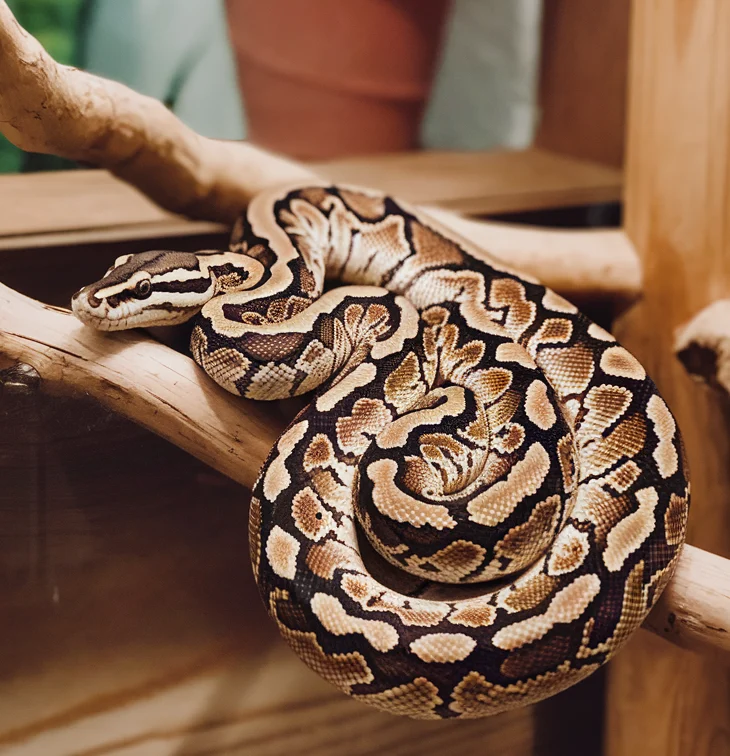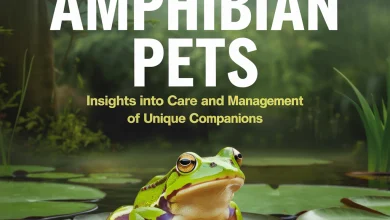Ball Pythons: A Beginner’s Guide to Caring for These Gentle Snakes

Ball pythons are one of the most popular pet snake species, especially for beginners. Known for their calm temperament and manageable size, these snakes are ideal for those new to reptile ownership. Ball pythons get their name from their habit of curling into a ball when they feel threatened, a behavior that highlights their gentle nature. If you’re considering a ball python as a pet, this guide will help you understand how to care for these fascinating reptiles.
1. Why Ball Pythons Make Great Pets
Ball pythons are excellent pets for both novice and experienced snake owners due to their friendly and docile nature:
- Calm Temperament: Ball pythons are typically non-aggressive and easy to handle, making them great pets for beginners or families.
- Manageable Size: Ball pythons generally grow to a manageable size of 3 to 5 feet, much smaller than other python species. Their size makes them easy to care for and house.
- Long Lifespan: With proper care, ball pythons can live for 20-30 years, making them a long-term commitment and lifelong companion for reptile lovers.
- Low Maintenance: Unlike dogs or cats, ball pythons don’t require daily attention. Their simple needs make them low-maintenance pets, perfect for someone looking for a quieter, less demanding animal.
2. Setting Up a Ball Python Habitat
Creating the right environment is crucial to keeping your ball python healthy and happy:
- Enclosure: A 20-40 gallon terrarium is typically large enough for an adult ball python. The enclosure should have a secure lid, as ball pythons are escape artists.
- Substrate: Use a substrate that retains moisture, such as coconut fiber, cypress mulch, or reptile-safe bedding. Avoid using cedar or pine shavings, as they can be toxic to snakes.
- Temperature and Humidity: Ball pythons need a temperature gradient in their enclosure. Provide a warm side (88-92°F) with a basking spot and a cooler side (75-80°F). Use heat lamps or under-tank heaters to maintain these temperatures. Humidity levels should be kept between 50-60%, which can be increased to 70% during shedding.
- Hiding Spots: Ball pythons are shy and need places to hide in their enclosure. Provide at least two hiding spots (one on the warm side and one on the cool side) to make them feel secure.
- Water Dish: Ensure your ball python has a large, shallow dish of clean water for drinking and soaking. The water also helps maintain proper humidity in the enclosure.
3. Feeding Your Ball Python
Ball pythons are carnivores that primarily eat rodents. Feeding your snake the right diet is essential to keeping it healthy:
- What to Feed: Ball pythons typically eat mice or rats. Hatchlings and young pythons will start with small prey like fuzzy mice, while adults can eat larger rats.
- Feeding Frequency: Young ball pythons should be fed once every 5-7 days, while adults only need to eat every 7-14 days. The prey size should be about the same width as the thickest part of your snake’s body.
- Frozen vs. Live Prey: It’s safer to feed frozen-thawed prey to your ball python to avoid injury from live rodents. If you opt to feed live prey, make sure to supervise feeding to prevent the rodent from harming your snake.
4. Handling and Behavior
Ball pythons are generally easy to handle, but it’s important to know how to interact with them:
- Start Slowly: If your ball python is new, give it time to adjust to its enclosure before handling it. Once it’s comfortable, start with short handling sessions, increasing the time gradually.
- Gentle Handling: Ball pythons enjoy being held, but always handle them gently and support their body. Avoid handling your snake when it’s shedding or just after feeding, as it may be stressed or defensive during these times.
- Signs of Stress: If your ball python curls into a tight ball or refuses to eat, it may be stressed. Make sure its environment is ideal, and limit handling until it seems more comfortable.
5. Common Health Issues and Care
Ball pythons are generally hardy, but like all pets, they can face health issues:
- Shedding Problems: If the humidity in your python’s enclosure is too low, it may experience incomplete sheds. Ensure proper humidity levels and provide a moist hide or soak the snake in warm water during shedding.
- Respiratory Infections: Cold temperatures or poor humidity can cause respiratory infections, leading to symptoms like wheezing or mucus in the mouth. If you notice signs of illness, consult a reptile veterinarian.
- Mites: External parasites like mites can be a problem for ball pythons. Regularly check your snake’s skin and the enclosure for signs of mites, and use reptile-safe treatments if necessary.
6. Fun Facts About Ball Pythons
- Native Habitat: Ball pythons are native to West and Central Africa, where they live in grasslands and savannas.
- Color Variations: There are many different color morphs of ball pythons available, from classic browns and blacks to exotic patterns like albino or pastel, making them a favorite among breeders and collectors.
- Defensive Behavior: When threatened, ball pythons curl into a ball rather than striking, a behavior that makes them less aggressive than other snake species.
Conclusion
Ball pythons are an ideal pet for those interested in reptiles. Their calm nature, ease of care, and beautiful appearance make them a wonderful addition to any household. By providing the right environment, proper nutrition, and handling them gently, you can ensure that your ball python lives a long, healthy, and happy life. Whether you’re a first-time snake owner or an experienced reptile enthusiast, a ball python is a rewarding and fascinating pet to have.



